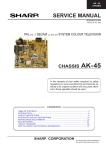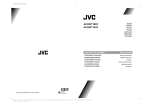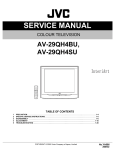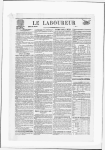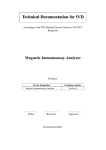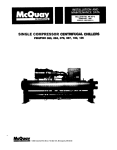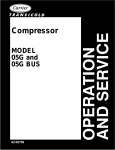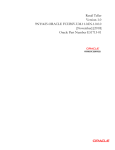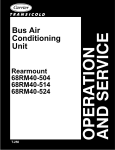Download SERVICE MANUAL
Transcript
SERVICE MANUAL COLOUR TELEVISION 52137 9 2003 AV-28KT1BUF/A, /B, /C, AV-28KT1SUF/A, /B, /C RM-C1100 TV TABLE OF CONTENTS 1 2 3 4 5 PRECAUTION. . . . . . . . . . . . . . . . . . . . . . . . . . . . . . . . . . . . . . . . . . . . . . . . . . . . . . . . . . . . . . . . . . . . . . . . . 1-3 SPECIFIC SERVICE INSTRUCTIONS . . . . . . . . . . . . . . . . . . . . . . . . . . . . . . . . . . . . . . . . . . . . . . . . . . . . . . 1-4 DISASSEMBLY . . . . . . . . . . . . . . . . . . . . . . . . . . . . . . . . . . . . . . . . . . . . . . . . . . . . . . . . . . . . . . . . . . . . . . . 1-6 ADJUSTMENT . . . . . . . . . . . . . . . . . . . . . . . . . . . . . . . . . . . . . . . . . . . . . . . . . . . . . . . . . . . . . . . . . . . . . . . 1-10 TROUBLESHOOTING . . . . . . . . . . . . . . . . . . . . . . . . . . . . . . . . . . . . . . . . . . . . . . . . . . . . . . . . . . . . . . . . . 1-23 COPYRIGHT © 2003 VICTOR COMPANY OF JAPAN, LIMITED No.52137 2003/9 SPECIFICATION Items Contents Dimensions ( W × H × D ) 76cm × 57cm × 47.3cm Mass 33kg TV RF System Colour System B/G, D/K, L/L' TV Mode PAL / SECAM Video Mode PAL / SECAM / NTSC 3.58 / NTSC 4.43 Sound System NICAM / A2 (Germany system) Teletext System FLOF (Fastext) / TOP (German system) Tuning System Frequency synthesizer tuning system Number of CH memory position 100 ch Receiving Frequency VHF Low 46.25MHz ~ 168.25MHz VHF High 175.25MHz ~ 463.25MHz UHF 471.25MHz ~ 863.25MHz CATV S01-S41 & S75-S79 VIF 38.9MHz (B/G, D/K, L) / 33.9MHz (L') Intermediate Frequency SIF 33.4MHz (5.5MHz:B/G) / 32.9MHz (6.0MHz:D/K) / 32.4MHz (6.5MHz:L) / 40.4MHz (6.5MHz:L') Colour Sub Carrier Frequency PAL (4.43MHz), SECAM (4.43MHz), NTSC (3.58MHz/4.43MHz) Power Input AC220V ~ AC240V, 50Hz Power Consumption 120W(Max), 3W(Standby) Aerial Input Terminal 75Ω unbalanced, coaxial Picture Tube Visible size : 66cm (Measured diagonally) High Voltage 30kV Speaker Main:5.7cm × 16cm oval type × 2 Audio Output Input 10W + 10W Video 1V(p-p) 75Ω S-Video Y : 1V(p-p) positive C : 0.286V(p-p) Output Input Terminal Audio (L/R) 500mV(rms) (-4dBs), High impedance (RCA pin jack × 2) Video 1V(p-p) 75Ω Audio (L/R) 500mV(rms), Low Impedance Rear Side EXT-1 (Video / Audio / RGB) Right Side EXT-3 (Video / Audio) Rear Side EXT-1 (Video / Audio) EXT-2 (Video / Audio / RGB / S-VHS) Output Terminal EXT-2 (Video / Audio) Right Side Remote Control Unit Headphone Jack (Stereo mini jack Ø3.5mm × 1) VE-30017763 (RM-C1100), (AA/R06 dry battery × 2) Design & specifications are subject to change without notice. 1-2 (No.52137) SECTION 1 PRECAUTION 1.1 SAFETY PRECAUTIONS (1) The design of this product contains special hardware, many circuits and components specially for safety purposes. For continued protection, no changes should be made to the original design unless authorized in writing by the manufacturer. Replacement parts must be identical to those used in the original circuits. Service should be performed by qualified personnel only. (2) Alterations of the design or circuitry of the products should not be made. Any design alterations or additions will void the manufacturer's warranty and will further relieve the manufacturer of responsibility for personal injury or property damage resulting therefrom. (3) Many electrical and mechanical parts in the products have special safety-related characteristics. These characteristics are often not evident from visual inspection nor can the protection afforded by them necessarily be obtained by using replacement components rated for higher voltage, wattage, etc. Replacement parts which have these special safety characteristics are identified in the parts list of Service manual. Electrical components having such features are identified by shading on the schematics and by ( ) on the parts list in Service manual. The use of a substitute replacement which does not have the same safety characteristics as the recommended replacement part shown in the parts list of Service manual may cause shock, fire, or other hazards. (4) Don't short between the LIVE side ground and ISOLATED (NEUTRAL) side ground or EARTH side ground when repairing. Some model's power circuit is partly different in the GND. The difference of the GND is shown by the LIVE : ( ) side GND, the ISOLATED (NEUTRAL) : ( ) side GND and EARTH : ( ) side GND. Don't short between the LIVE side GND and ISOLATED (NEUTRAL) side GND or EARTH side GND and never measure the LIVE side GND and ISOLATED (NEUTRAL) side GND or EARTH side GND at the same time with a measuring apparatus (oscilloscope etc.). If above note will not be kept, a fuse or any parts will be broken. (5) If any repair has been made to the chassis, it is recommended that the B1 setting should be checked or adjusted (See B1 POWER SUPPLY check). (6) The high voltage applied to the picture tube must conform with that specified in Service manual. Excessive high voltage can cause an increase in X-Ray emission, arcing and possible component damage, therefore operation under excessive high voltage conditions should be kept to a minimum, or should be prevented. If severe arcing occurs, remove the AC power immediately and determine the cause by visual inspection (incorrect installation, cracked or melted high voltage harness, poor soldering, etc.). To maintain the proper minimum level of soft X-Ray emission, components in the high voltage circuitry including the picture tube must be the exact replacements or alternatives approved by the manufacturer of the complete product. (7) Do not check high voltage by drawing an arc. Use a high voltage meter or a high voltage probe with a VTVM. Discharge the picture tube before attempting meter connection, by connecting a clip lead to the ground frame and connecting the other end of the lead through a 10kΩ 2W resistor to the anode button. (8) When service is required, observe the original lead dress. Extra precaution should be given to assure correct lead dress in the high voltage circuit area. Where a short circuit has occurred, those components that indicate evidence of overheating should be replaced. Always use the manufacturer's replacement components. (9) Isolation Check (Safety for Electrical Shock Hazard) After re-assembling the product, always perform an isolation check on the exposed metal parts of the cabinet (antenna terminals, video/audio input and output terminals, Control knobs, metal cabinet, screw heads, earphone jack, control shafts, etc.) to be sure the product is safe to operate without danger of electrical shock. a) Dielectric Strength Test The isolation between the AC primary circuit and all metal parts exposed to the user, particularly any exposed metal part having a return path to the chassis should withstand a voltage of 3000V AC (r.m.s.) for a period of one second. (. . . . Withstand a voltage of 1100V AC (r.m.s.) to an appliance rated up to 120V, and 3000V AC (r.m.s.) to an appliance rated 200V or more, for a period of one second.) This method of test requires a test equipment not generally found in the service trade. b) Leakage Current Check Plug the AC line cord directly into the AC outlet (do not use a line isolation transformer during this check.). Using a "Leakage Current Tester", measure the leakage current from each exposed metal part of the cabinet, particularly any exposed metal part having a return path to the chassis, to a known good earth ground (water pipe, etc.). Any leakage current must not exceed 0.5mA AC (r.m.s.). However, in tropical area, this must not exceed 0.2mA AC (r.m.s.). Alternate Check Method Plug the AC line cord directly into the AC outlet (do not use a line isolation transformer during this check.). Use an AC voltmeter having 1000Ω per volt or more sensitivity in the following manner. Connect a 1500Ω 10W resistor paralleled by a 0.15µF AC-type capacitor between an exposed metal part and a known good earth ground (water pipe, etc.). Measure the AC voltage across the resistor with the AC voltmeter. Move the resistor connection to each exposed metal part, particularly any exposed metal part having a return path to the chassis, and measure the AC voltage across the resistor. Now, reverse the plug in the AC outlet and repeat each measurement. Any voltage measured must not exceed 0.75V AC (r.m.s.). This corresponds to 0.5mA AC (r.m.s.). However, in tropical area, this must not exceed 0.3V AC (r.m.s.). This corresponds to 0.2mA AC (r.m.s.). AC VOLTMETER (HAVING 1000 /V, OR MORE SENSITIVITY) 0.15 F AC-TYPE 1500 10W PLACE THIS PROBE ON EACH EXPOSED METAL PART GOOD EARTH GROUND (No.52137)1-3 SECTION 2 SPECIFIC SERVICE INSTRUCTIONS 2.1 21-pin Euro connector (SCART) : EXT-1 / EXT-2 Pin No. Signal Designation Matching Value EXT-1 EXT-2 1 AUDIO R output 500mV(rms) (Nominal), Low impedance Used Used 2 AUDIO R input 500mV(rms) (Nominal), High impedance Used (R1) Used (R2) 3 AUDIO L output 500mV(rms) (Nominal), Low impedance Used Used 4 AUDIO GND --- Used Used 5 GND (B) --- Used Used 6 AUDIO L input 500mV(rms) (Nominal), High impedance Used (L1) Used (L2) 7 B input 700mV(B-W), 75 Ω Used Used 8 FUNCTION SW (SLOW SW) Low : 0V-3V, High : 8V-12V, High impedance Used Used 9 GND (G) --- Used Used 10 SCL / T-V LINK --- Not used Used (SCL / TV-LINK) 11 G input 700mV(B-W), 75 Ω Used Used 12 SDA3 --- Not used Not used 13 GND (R) --- Used Used 14 GND (YS) --- Used Used 15 R / C input R : 700mV(B-W), 75 Ω C : 300mV(P-P), 75 Ω Used (R) Used (C2/R) 16 Ys input (FAST SW) Low : 0V-0.4V, 75 Ω High : 1V-3V, 75 Ω Used Used 17 GND (VIDEO output) --- Used Used 18 GND (VIDEO input) --- Used Used 19 VIDEO output 1V(P-P) (Negative sync), 75 Ω Used Used 20 VIDEO / Y input 1V(P-P) (Negative sync), 75 Ω Used Used 21 COMMON GND --- Used Used (P-P= Peak to Peak, B-W= Blanking to white peak) [Pin assignment] 20 21 1-4 (No.52137) 18 16 19 17 14 15 12 13 11 10 8 9 6 7 4 5 2 3 1 2.2 FEATURES • It is a remote controlled color television. • 100 programs from VHF, UHF bands or cable channels can be preset. • It can tune cable channels. • Controlling the TV is very easy by its menu driven system. • It has two Euroconnector sockets for external device (such as video recorder, video games, audio set, etc.) • Side AV Input (EXT-3) available. • Stereo sound systems (German + Nicam) are available. • Full function Teletext (Fastext, Toptext). • It is possible to connect headphone. • Direct channel access. 2.3 APS (Automatic Programming System). All programs can be named. Forward or backward automatic tuning. Sleep timer. Child Lock. Blue Background T-V Link Automatic sound mute when no transmission. 5 minutes after the broadcasting (close down), the TV switches itself automatically to stand-by mode. • WSS (Wide Screen Signaling) • NTSC Playback. MAIN DIFFERENCE LIST Part Name 2.4 • • • • • • • • • AV-28KT1BUF AV-28KT1SUF MODEL COLOUR BLACK MODEL SILVER MODEL FRONT CABINET VE-20121492 VE-20119985 BACK COVER VE-20121494 VE-20111863 BACK DOOR VE-20108124 VE-20120043 FUNCTION BUTTON VE-20091798 VE-20096498 POWER BUTTON VE-20111864 VE-20120046 JVC LOGO VE-40013592 VE-40013593 CARTON BOX VE-50038917 VE-50038907 DIFFERENCE LIST BY ELECTRONICS Part Name MAIN PWB AV-28KT1BUF/A AV-28KT1SUF/A AV-28KT1BUF/B AV-28KT1SUF/B AV-28KT1BUF/C AV-28KT1SUF/C VE-20120604 VE-20127801 VE-20127796 IC500 (MI-COM) VE-20139901 VE-20137151 VE-20139902 IC502 (MEMORY) VE-20120610 VE-20134092 VE-20126318 AV-28KT1BUF/A AV-28KT1SUF/A AV-28KT1BUF/B AV-28KT1SUF/B AV-28KT1BUF/C AV-28KT1SUF/C ENG, GER, FRE, ITA SPA, DUT, POR, TUR ENG, GER, FRE, SWE NOR, DAN, FIN, GRE ENG, GER, CZE, POL HUN, BUL, ROM, CRO 2.5 DIFFERENCE LIST BY OSD LANGUAGE Part Name OSD LANGUAGES (No.52137)1-5 SECTION 3 DISASSEMBLY 3.1 DISASSEMBLY PROCEDULE 3.1.1 (1) (2) (3) (4) REMOVING THE REAR COVER Unplug the power cord. Remove the 8 screws [A] as shown in the Fig. 1. Remove the 4 screws [B]. Withdraw the REAR COVER toward you. 3.1.2 REMOVING THE BACK DOOR • Remove the REAR COVER (1) Remove the 2 screws [C]. (2) Withdraw the BACK DOOR toward you. 3.1.9 CHECKING THE PW BOARD • To check the back side of the PW Board. (1) Pull out the PW Board. (Refer to REMOVING THE MAIN PWB). (2) Erect the PW Board vertically so that you can easily check the back side of the PW Board. 3.1.3 REMOVING THE SPEAKER • Remove the REAR COVER. (1) Remove the 4 screws [I], and remove the SPEAKER. (2) Remove the other hand SPEAKER in the same steps. 3.1.10 CAUTION • When erecting the PW Board, be careful so that there will be no contacting with other PW Board. • Before turning on power, make sure that the wire connector is properly connected. • When conducting a check with power supplied, be sure to confirm that the CRT EARTH WIRE (BRAIDED ASS'Y) is connected to the CRT SOCKET PW board. 3.1.4 REMOVING THE MAIN PWB • Remove the REAR COVER. • Remove the BACK DOOR. (1) Remove the 4 screws [D]. (2) Slightly raise the both sides of the MAIN PWB by hand and withdraw the MAIN PWB backward. 3.1.11 WIRE CLAMPING AND CABLE TYING (1) Be sure to clamp the wire. (2) Never remove the cable tie used for tying the wires together. Should it be inadvertently removed, be sure to tie the wires with a new cable tie. CAUTION: If necessary, take off the wire clamp, connectors etc. Be careful enough when developing a MAIN PWB. 3.1.5 REMOVING THE SIDE CONTROL PWB • Remove the REAR COVER. (1) Remove the 4 screws [E]. (2) Remove the SIDE PWB. 3.1.6 REMOVING THE BASE • Remove the REAR COVER. (1) Remove the 2 screws [F]. (2) Remove the BASE. NOTE: Work after fixing so that a CRT screen may be placed upside down or it may not fall. 3.1.7 REMOVING THE POWER SWITCH PWB • Remove the REAR COVER. • Remove the BASE. (1) Remove the 2 screws [G], and remove the POWER SWITCH PWB. 3.1.8 REMOVING THE LED PWB • Remove the REAR COVER. • Remove the BASE. • Remove the POWER SWITCH PWB. (1) Remove the 2 screws [H], and remove the LED PWB. 1-6 (No.52137) REAR COVER D x4 x4 B MAIN PWB A x8 C x2 BACK DOOR BASE F x2 CRT SOCKET PWB x4 I SPEAKER SIDE CONTROL PWB E x4 x4 I LED PWB G x2 H x2 POWER SWITCH PWB Fig.1 (No.52137)1-7 3.2 REPLACEMENT OF CHIP COMPONENT 3.2.1 CAUTIONS (1) Avoid heating for more than 3 seconds. (2) Do not rub the electrodes and the resist parts of the pattern. (3) When removing a chip part, melt the solder adequately. (4) Do not reuse a chip part after removing it. 3.2.2 SOLDERING IRON (1) Use a high insulation soldering iron with a thin pointed end of it. (2) A 30w soldering iron is recommended for easily removing parts. 3.2.3 REPLACEMENT STEPS 1. How to remove Chip parts 2. How to install Chip parts [Resistors, capacitors, etc.] [Resistors, capacitors, etc.] (1) As shown in the figure, push the part with tweezers and alternately melt the solder at each end. (1) Apply solder to the pattern as indicated in the figure. (2) Grasp the chip part with tweezers and place it on the solder. Then heat and melt the solder at both ends of the chip part. (2) Shift with the tweezers and remove the chip part. [Transistors, diodes, variable resistors, etc.] [Transistors, diodes, variable resistors, etc.] (1) Apply extra solder to each lead. SOLDER (1) Apply solder to the pattern as indicated in the figure. (2) Grasp the chip part with tweezers and place it on the solder. (3) First solder lead A as indicated in the figure. SOLDER (2) As shown in the figure, push the part with tweezers and alternately melt the solder at each lead. Shift and remove the chip part. A B C (4) Then solder leads B and C. A B NOTE : After removing the part, remove remaining solder from the pattern. 1-8 (No.52137) C 3.3 SETTING OF THE LAST MEMORY FOR SHIPMENT 3.3.1 USER SETTING VALUES Setting Item Setting Value Setting Item SOUND MENU BALANCE Setting Value FEATURE MENU CENTER SLEEP TIMER OFF BASS CENTER CHILD LOCK OFF TREBLE CENTER LANGUAGE ENGLISH HYPER SOUND OFF EXT-2 OUTPUT TV BLUE BACKGROUND ON PICTURE MENU BRIGHTNESS CONTRAST COLOUR SHARPNESS These adjust are automatically restored when A.P.S. bit in Service menu is set. The procedure for setting APS bit is described bellow. HUE (only NTSC) INSTALL. MENU PROGRAMME Refer to instruction book BAND CHANNEL STANDARD PICTURE MODE USER COLOUR SYSTEM COLOUR TEMP NORMAL DECODER (EXT-2) ZOOM AUTO FINE TUNING SEARCH STORE 3.3.2 SETTING A.P.S. (AUTO STORE) (1) Press [MENU] key on the remote control unit to display the main menu. (2) Press [/] keys to select PROGRAM item, them [/] keys to display the PROGRAM menu. (3) Press the [BLUE] key to enter the AUTOSTORE mode. (4) Press [/] keys to choose the COUNTRY, then press [/] keys the choose country you are nou located. (5) Press [/] keys to choose the CONTINUE, then press [] key to start A.P.S. The following message appears. NOTE: To cancel the A.P.S., press the [STANDARD] key. (6) After A.P.S. is finalized, the PROGRAM menu appears again. (7) Press [STANDARD] key to exit main menu. (No.52137)1-9 SECTION 4 ADJUSTMENT 4.1 ADJUSTMENT PREPARATION (1) You can make the necessary adjustments for this unit with either the Remote Control Unit or with the adjustment tools and parts as given below. (2) Adjustment with the Remote Control Unit is made on the basis of the initial setting values, however, the new setting values which set the screen to its optimum condition may differ from the initial settings. (3) Make sure that AC power is turned on correctly. (4) Turn on the power for set and test equipment before use, and start the adjustment procedures after waiting at least 30 minutes. (5) Unless otherwise specified, prepare the most suitable reception or input signal for adjustment. (6) Never touch any adjustment parts which are not specified in the list for this adjustment - variable resistors, transformers, condensers, etc. (7) Presetting before adjustment. Unless otherwise specified in the adjustment instructions, preset the following functions with the remote control unit: Setting Item Setting value BRIGHTNESS CENTER CONTRAST COLOUR SHARPNESS COLOUR TEMP ZOOM 4.2 AUTO MEASURING EQUIPMENT (1) DC voltmeter (or digital voltmeter) (2) Signal generator (Pattern generator) [PAL / SECAM / NTSC] (3) Remote control unit 4.3 ADJUSTMENT ITEM • SCREEN ADJUSTMENT • DEFLECTION CIRCUIT ADJUSTMENT • WHITE BALANCE ADJUSTMENT 4.4 ADJUSTMENT LOCATIONS FRONT IC500 (MI-COM) TOP IC502 (MEMORY) MAIN PWB HEADPHONE MENU P/Ch VIDEO FBT SIDE CONTROL PWB TUNER TU200 1-10 (No.52137) UPPER : FOCUS LOWER : SCREEN 4.5 BASIC OPERATION OF SERVICE MENU 4.5.1 HOW TO ENTER THE SERVICE MENU (1) Press the [INFORMATION] key and [MUTING] key simultaneously in the main menu, and the SERVICE MENU screen (Fig.1) will be displayed. REMOTE CONTROL UNIT key NAME SERVICE MENU MUTING key SERVICE ADJUST... OPTIONS... AK45JA*** AK45JA*** INFORMATION key Select for adjustment Do not adjust Fig.1 (2) While the SERVICE MENU screen is displayed, press the [/] and [/] key and select the "ADJUST...", then ADJUST MENU sucreen (Fig.2) will be displayed. ADJUST MENU MENU key UP / DOWN [ ] key LEFT / RIGHT [ ] key ADJUST... 000 001 002 003 004 005 006 007 008 009 *** *** *** *** *** *** *** *** *** *** SETTING ITEM No. SETTING VALUE Fig.2 4.5.2 SELECTION OF ADJUSTMENT ITEMS (1) Enter the SERVICE MENU and select ADJUST. (2) Press the [/] key and select the ADJUSTMENT ITEM. (3) Press the [/] key and set the SETTING VALUE. (4) Changed values are stored automatically. 4.5.3 HOW TO EXIT SERVICE MODE (1) Press the [MENU] key. (No.52137)1-11 4.5.4 SERVICE MENU SCREEN SERVICE MENU SERVICE ADJUST... OPTIONS... AK45JA*** AK45JA*** ADJUST MENU ADJUST... 000 001 002 003 004 005 006 007 008 009 *** *** *** *** *** *** *** *** *** *** SETTING ITEM No. 000~143 SETTING VALUE Do Not Adjust OPTIONS MENU OPTIONS.. 000 001 002 003 004 005 006 007 008 009 ** ** ** ** ** ** ** ** ** ** ******** ******** ******** ******** ******** ******** ******** ******** ******** ******** SETTING ITEM No. 000~063 SETTING VALUE NOTE: Do not adjust the OPTIONS MENU. If you change the setting value, the set will not function correctly. 1-12 (No.52137) ADJUSTMENT ITEM adjustment No. adjustment part description 000 White Point RED Not used 001 White Point GREEN Not used 002 Whit Point BLUE Not used 003 AGC (Automatic Gain Control) 004 IF-PLL Negative Not used 005 IF-PLL Positive Not used 006 Y-Delay 007 Y-Delay SECAM 008 Y-Delay NTSC 009 Y-Delay OTHER 010 Vertical Position Offset Not used Fixed 011 Vertical Amplitude Offset Fixed 012 Horizontal Position Offset Fixed 013 Horizontal Amplitude Offset Fixed 014 Vertical Blank Start (It will be used only at 4:3 tube for 16:9 mode adjustment) 015 Vertical Blank Stop (It will be used only at 4:3 tube for 16:9 mode adjustment) 016 Angle 017 Bow 018 4:3 Horz. Blank Start Do not adjust 019 4:3 Horz. Blank Stop Do not adjust 020 EHTV compensation 021 EHTTM compensation 022 EHTEW compensation 023 WDR 024 WDG 025 WDB 026 CR 027 CG 028 CB 029 COR coring level 030 REGULAR VERT_POS (Vertical Position) 031 REGULAR VERT_AMPL (Vertical Amplitude) 032 REGULAR VERT_SCOR (Vertical S Correction) 033 REGULAR VERT_SSYM (Vertical S Symmetry) 034 REGULAR TRAPEZE 035 REGULAR CUSHION 036 REGULAR HOR_COR_SYM(Horizontal Corner Symmetry) 037 REGULAR HOR_CORNER (Horizontal Corner) 038 REGULAR HORZ_POS (Horizontal Position) 039 REGULAR HORZ_AMPL (Horizontal Amplitude) 040 PANORAMIC VERT_POS Video processor adjust itself. Not used 041 PANORAMIC VERT_AMPL Not used 042 PANORAMIC VERT_SCOR Not used 043 PANORAMIC VERT_SSYM Not used 044 PANORAMIC TRAPEZE Not used 045 PANORAMIC CUSHION Not used 046 PANORAMIC HOR_COR_SYM Not used 047 PANORAMIC HOR_CORNER Not used 048 PANORAMIC HORZ_POS Not used (No.52137)1-13 adjustment No. adjustment part description 049 PANORAMIC HORZ_AMPL Not used 050 14:9 ZOOM VERT_POS Not used 051 14:9 ZOOM VERT_AMPL Not used 052 14:9 ZOOM VERT_SCOR Not used 053 14:9 ZOOM VERT_SSYM Not used 054 14:9 ZOOM TRAPEZE Not used 055 14:9 ZOOM CUSHION Not used 056 14:9 ZOOM HOR_COR_SYM Not used 057 14:9 ZOOM HOR_CORNER Not used 058 14:9 ZOOM HORZ_POS Not used 059 14:9 ZOOM HORZ_AMPL Not used 060 16:9 ZOOM VERT_POS Not used 061 16:9 ZOOM VERT_AMPL Not used 062 16:9 ZOOM VERT_SCOR Not used 063 16:9 ZOOM VERT_SSYM Not used 064 16:9 ZOOM TRAPEZE Not used 065 16:9 ZOOM CUSHION Not used 066 16:9 ZOOM HOR_COR_SYM Not used 067 16:9 ZOOM HOR_CORNER Not used 068 16:9 ZOOM HORZ_POS Not used 069 16:9 ZOOM HORZ_AMPL Not used 070 16:9 ZOOM SUBTITLE VERT_POS Not used 071 16:9 ZOOM SUBTITLE VERT_AMPL Not used 072 16:9 ZOOM SUBTITLE VERT_SCOR Not used 073 16:9 ZOOM SUBTITLE VERT_SSYM Not used 074 16:9 ZOOM SUBTITLE TRAPEZE Not used 075 16:9 ZOOM SUBTITLE CUSHION Not used 076 16:9 ZOOM SUBTITLE HOR_COR_SYM Not used 077 16:9 ZOOM SUBTITLE HOR_CORNER Not used 078 16:9 ZOOM SUBTITLE HORZ_POS Not used 079 16:9 ZOOM SUBTITLE HORZ_AMPL Not used 080 OSD Position 081 BCLTHR Beam current threshold 082 BCLG Beam current loop gain 083 ROTATION (TILT) 084 LSLSA Luma soft limiter Fixed 085 LSLSB Luma soft limiter Fixed 086 LSL2 Luma soft limiter Fixed 087 LSLTA Luma soft limiter Fixed 088 LSLTB Luma soft limiter Fixed 089 REFERENCE WDR RED (NORMAL) 090 REFERENCE WDR GREEN (NORMAL) 091 REFERENCE WDR BLUE (NORMAL) 092 REFERENCE CUTOFF RED 093 REFERENCE CUTOFF GREEN Fixed 094 REFERENCE CUTOFF BLUE Fixed 095 IBRM 096 WDRV 097 ACC_SAT (COLOUR OFFSET) 098 G2_CUTOFF_REFERENCE 1-14 (No.52137) Fixed Fixed adjustment No. adjustment part 099 G2_WDR_REFERENCE 100 POFS2 (RGB HORIZANTAL SHIFT) 101 REFERENCE WDR RED COOL 102 REFERENCE WDR GREEN COOL 103 REFERENCE WDR BLUE COOL 104 REFERENCE WDR RED WARM 105 REFERENCE WDR GREEN WARM 106 REFERENCE WDR BLUE WARM 107 STANDARD MODE BRIGHTNESS 108 STANDARD MODE COLOUR 109 STANDARD MODE CONTRAST 110 FULL VERT_POS (16:9 MODE) 111 FULL VERT_AMPL 112 FULL VERT_SCOR 113 FULL VERT_SSYM 114 FULL TRAPEZE 115 FULL CUSHION 116 FULL HOR_COR_SYM 117 FULL HOR_CORNER 118 FULL HORZ_POS 119 FULL HORZ_AMPL 120 BRIGHT MODE BRIGHTNESS 121 BRIGHT MODE COLOUR 122 BRIGHT MODE CONTRAST 123 SOFT MODE BRIGHTNESS 124 SOFT MODE COLOUR 125 SOFT MODE CONTRAST 126 PERSONAL MODE FACTORY SETTING BRIGHTNESS description Fixed Fixed 127 PERSONAL MODE FACTORY SETTING COLOUR Fixed 128 PERSONAL MODE FACTORY SETTING CONTRAST Fixed 129 SCINC FOR PANORAMIC MODE 130 SCINC1 FOR PANORAMIC MODE 131 VOLUME AFTER APS 132 VERTICAL SCROLL 133 14:9 HORIZONTAL START Not used 134 14:9 HORIZONTAL STOP Not used 135 4:3 RGB HORIZONTAL AMPLITUDE 136 4:3 RGB CUSHION 137 14:9 RGB HORIZONTAL AMPLITUDE Not used 138 14:9 RGB CUSHION Not used 139 PANAROMIC RGB HORIZONTAL AMPLITUDE Not used 140 16:9 RGB HORIZONTAL AMPLITUDE Not used 141 16:9 SUBTITLE RGB HORIZONTAL AMPLITUDE Not used 142 FULL RGB HORIZONTAL AMPLITUDE 143 TELETEXT HORIZONTAL POSITION (No.52137)1-15 4.6 ADJUSTMENT PROCEDURE 4.6.1 FOCUS / SCREEN ADJUSTMENT Item FOCUS adjustment Measuring instrument Test point Signal generator Adjustment part FOCUS VR [On the FBT] Description (1) Receive a PAL cross-hatch signal. (2) Adjust FOCUS VR on the FBT as thin as possible. Remote control unit FOCUS VR SCREEN VR FBT SCREEN adjustment Remote control unit SCREEN VR [On the FBT] (1) Enter the OPTIONS MENU. (2) Select option No.002 and change bit 6 from 0 to 1 disabling vertical scan. Then horizontal line appears. (3) Adjust horizontal line as thin as possible via screen adjust pot. (4) Press number 0 key to leave service menu. 4.6.2 AGC ADJUSTMENT Item AGC adjustment Measuring instrument Signal generator Remote control unit Volt meter 1-16 (No.52137) Test point Adjustment part 003 Description (1) (2) (3) (4) (5) Receive a PAL BG signal at 60dBµV RF signal level. Enter the SERVICE MENU. Select ADJUST MENU. Select 003. Adjust 003 by pressing till voltage at pin 1 of TUNER is equal to 3.0V. 4.6.3 DEFLECTION CIRCUIT ADJUSTMENT Measuring instrument Item VERTICAL POSITION adjustment Signal generator Test point Adjustment part 030 110 (16:9 mode) Remote control unit VERTICAL SIZE Signal adjustment generator 031 111 (16:9 mode) Remote control unit Very close Picture size 100% Screen size Description (1) (2) (3) (4) (5) (6) Receive a PAL circle pattern signal. Enter the SERVICE MENU. Select ADJUST MENU. Select 030. Adjust 030 to make A=B. Check and readjust 030 item if the adjustment becomes improper after some other geometric adjustments are done. (7) Select 110 (16:9 mode). (8) Adjust 110 in the same procedure. (1) (2) (3) (4) (5) Receive a PAL cross-hatch signal. Enter the SERVICE MENU. Select ADJUST MENU. Select 031. Adjust 031 until horizontal black lines on both the upper and lower part of the cross-hatch pattern become very closeted the upper and lower horizontal sides of picture size and nearly about to disappear. (6) Check and readjust 031 item if the adjustment becomes improper after some other geometric adjustments are done. (7) Select 111 (16:9 mode). (8) Adjust 111 in the same procedure. Very close VERTICAL Signal S-CORRECTION generator & LINEARITY adjustment Remote control unit 032 033 112 (16:9 mode) (1) (2) (3) (4) (5) 113 (16:9 mode) (6) UPPER (7) (8) CENTER (9) LOWER (10) (11) (12) (13) Receive a PAL cross-hatch signal. Enter the SERVICE MENU. Select ADJUST MENU. Select 032. Adjust 032 till the size of squares on both the upper and lower part of cross-hatch pattern become equal to the squares laying on the vertical center of the cross-hatch pattern. Check and readjust 032 item if the adjustment becomes improper after some other geometric adjustments are done. Select 033. Adjust 033 till all the size of squares of the crosshatch pattern become in equal size from the top of the screen to its bottom of the whole screen. Check and readjust 033 item if the adjustment becomes improper after some other geometric adjustments (especially after than S-COR adjustment) are done. Select 112 (16:9 mode). Adjust 112 in the same procedure as 5. Select 113 (16:9 mode). Adjust 113 in the same procedure as 8. (No.52137)1-17 Measuring instrument Item HORIZONTAL POSITION adjustment Test point Adjustment part 038 Signal generator 118 (16:9 mode) Remote control unit C HORIZONTAL SIZE adjustment D Signal generator 039 119 (16:9 mode) Remote control unit Very close Very close Screen size Description (1) (2) (3) (4) (5) (6) Receive a PAL circle pattern signal. Enter the SERVICE MENU. Select ADJUST MENU. Select 038. Adjust 038 to make C=D. Check and readjust 038 item if the adjustment becomes improper after some other geometric adjustments are done. (7) Select 118 (16:9 mode). (8) Adjust 118 in the same procedure. (1) (2) (3) (4) (5) Receive a PAL cross-hatch signal. Enter the SERVICE MENU. Select ADJUST MENU. Select 039. Adjust 039 until vertical lines on both the left and right part of the cross-hatch will be visible nor screen will be so wide. (6) Check and readjust 039 item if the adjustment becomes improper after some other geometric adjustments are done. (7) Select 119 (16:9 mode). (8) Adjust 119 in the same procedure. Picture size 100% ANGLE adjustment Signal generator Remote control unit 1-18 (No.52137) 016 (1) (2) (3) (4) (5) Receive a PAL cross-hatch signal. Enter the SERVICE MENU. Select ADJUST MENU. Select 016. Adjust 016 till the vertical lines of the cross-hatch pattern become straight. (6) Check and readjust 016 item if the adjustment becomes improper after some other geometric adjustments are done. Item BOW adjustment Measuring instrument Test point Signal generator Adjustment part 017 Remote control unit Description (1) (2) (3) (4) (5) (6) Receive a PAL cross-hatch signal. Enter the SERVICE MENU. Select ADJUST MENU. Select 017. Adjust 017 till the vertical lines become straight. Check and readjust 017 item if the adjustment becomes improper after some other geometric adjustments are done. NOTE: In case where there is a bow-shaped distortion of images on the screen. (Figure) TRAPEZIUM adjustment Signal generator 034 114 (16:9 mode) Remote control unit Parallel SIDE PIN adjustment Signal generator 035 115 (16:9 mode) Remote control unit Parallel (1) (2) (3) (4) (5) Receive a PAL cross-hatch signal. Enter the SERVICE MENU. Select ADJUST MENU. Select 034. Adjust 034 till vertical lines, especially lines at the sides of the picture frame become parallel to the both sides of picture tubes as close as possible. (6) Check and readjust 034 item if the adjustment becomes improper after some other geometric adjustments are done. (7) Select 114 (16:9 mode). (8) Adjust 114 in the same procedure. (1) (2) (3) (4) (5) Receive a PAL cross-hatch signal. Enter the SERVICE MENU. Select ADJUST MENU. Select 035. Adjust 035 till vertical lines close to the both sides of the picture frame become parallel to vertical sides of picture tube without any bending to left or to right side of the screen. (6) Check and readjust 035 item if the adjustment becomes improper after some other geometric adjustments are done. (7) Select 115 (16:9 mode). (8) Adjust 115 in the same procedure. (No.52137)1-19 Measuring instrument Item CORNER adjustment Test point Adjustment part 036 Signal generator 037 Remote control unit 116 (16:9 mode) Description (1) (2) (3) (4) (5) 117 (16:9 mode) (6) Straight Straight (7) (8) (9) (10) (11) (12) (13) ROTATION adjustment Signal generator 083 (1) (2) (3) (4) (5) Receive a PAL cross-hatch signal. Enter the SERVICE MENU. Select ADJUST MENU. Select 083. Adjust 083 to rotate the complete master clock-wise and counter clock-wise depending on the CRT. (6) Check and readjust 083 item if the adjustment becomes improper after some other geometric adjustments are done. 135 (1) (2) (3) (4) (5) Remote control unit NTSC HORIZONAL SIZE adjustment Signal generator 142 (16:9 mode) Remote control unit Very close Screen size Picture size 100% 1-20 (No.52137) Receive a PAL cross-hatch signal. Enter the SERVICE MENU. Select ADJUST MENU. Select 036. Adjust 036 till vertical lines at the upper corners of the picture frame become vertical and parallel to vertical corner sides of picture tube. Check and readjust 036 item if the adjustment becomes improper after some other geometric adjustments are done. Select 037. Adjust 037 till vertical lines at the lower corners of the picture frame become vertical and parallel to vertical corner sides of picture tube. Check and readjust 037 item if the adjustment becomes improper after some other geometric adjustments are done. Select 116 (16:9 mode). Adjust 116 in the same procedure as 5. Select 117 (16:9 mode). Adjust 117 in the same procedure as 8. Very close Receive a NTSC cross-hatch signal. Enter the SERVICE MENU. Select ADJUST MENU. Select 135. Adjust 135 till vertical lines on both the left and right part of the cross-hatch will be visible nor screen will be so wide. (6) Check and readjust TRAPEZ item if the adjustment becomes improper after some other geometric adjustments are done. (7) Select 142 (16:9 mode). (8) Adjust 142 in the same procedure. Item NTSC SIDE PIN adjustment Measuring instrument Test point Signal generator Adjustment part 136 (1) (2) (3) (4) (5) 143 (1) (2) (3) (4) (5) Remote control unit Parallel TELETEXT SCREEN adjustment Signal generator Remote control unit Description Receive a NTSC cross-hatch signal. Enter the SERVICE MENU. Select ADJUST MENU. Select 136. Adjust 136 till vertical lines close to the both sides of the picture frame become parallel to vertical sides of picture tube without any bending to left or to right side of the screen. (6) Check and readjust 136 item if the adjustment becomes improper after some other geometric adjustments are done. Receive a PAL cross-hatch signal. Enter the SERVICE MENU. Select ADJUST MENU. Select 143. Adjust 143 to adjust the proper vertical size of Teletext screen. (6) Check and readjust 143 item if the adjustment becomes improper after some other geometric adjustments are done. (No.52137)1-21 4.6.4 VIDEO CIRCUIT Item WHITE BALANCE adjustment Measuring instrument Signal generator Test point Adjustment part 023 024 Remote control unit 025 Description (1) (2) (3) (4) (5) Receive a PAL black & white signal. Enter the SERVICE MENU. Select ADJUST MENU. Select 023, 024 and 025 respectively. Adjust 023, 024 and 025 respectively, until the white part turns to pure white without any other colour. (1) (2) (3) (4) (5) Receive a PAL cross-hatch signal. Enter the SERVICE MENU. Select ADJUST MENU. Select 026, 027 and 028 respectively. Adjust 026, 027 and 028 respectively, until the black part turns to pure black without any other colour. COLOUR Signal CUTOFF LEVEL generator adjustment Remote control unit 026 PAL Y DELAY adjustment 006 (1) (2) (3) (4) (5) Receive a PAL colour bar signal. Enter the SERVICE MENU. Select ADJUST MENU. Select 006. Adjust 006 till the colour transients on the colour bar pattern becomes as sharper and possible as colours between transients do not mix with each other. 007 (1) (2) (3) (4) (5) Receive a SECAM colour bar signal. Enter the SERVICE MENU. Select ADJUST MENU. Select 007. Adjust 007 by pressing till the colour transients on the colour bar pattern becomes as sharper and possible as colouers between transients do not mix with each other. 008 (1) Receive a NTSC colour bar signal from an external source (e.g. FRONT AV : EXT-3). (2) Enter the SERVICE MENU. (3) Select ADJUST MENU. (4) Select 008. (5) Adjust 008 by pressing till the colour transients on the colour bar pattern becomes as sharper and possible as colouers between transients do not mix with each other. Signal generator 027 028 Remote control unit SECAM Y DELAY adjustment Signal generator Remote control unit NTSC Y DELAY adjustment Signal generator Remote control unit 1-22 (No.52137) SECTION 5 TROUBLESHOOTING This service manual does not describe TROUBLESHOOTING. (No.52137)1-23 VICTOR COMPANY OF JAPAN, LIMITED AV & MULTIMEDIA COMPANY VIDEO DISPLAY CATEGORY 12, 3-chome, Moriya-cho, kanagawa-ku, Yokohama, kanagawa-prefecture, 221-8528, Japan (No.52137) Printed in Japan WPC
























